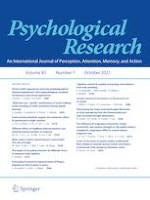12-09-2020 | Original Article
“Walk this way”: specific contributions of active walking to the encoding of metric properties during spatial learning
Gepubliceerd in: Psychological Research | Uitgave 7/2021
Log in om toegang te krijgenAbstract
The effect of body-based information on spatial memory has been traditionally described as a facilitating factor for large-scale spatial learning in the field of active learning research (Chrastil & Warren, Psychonomic Bulletin and Review, 19(1):1–23; 2012). The specific contribution of body-based information to spatial representation properties is however not yet well defined and the mechanisms through which body-based information contributes to spatial learning are not clear enough. To disambiguate the effect of active spatial learning on the quality of spatial representations from the beneficial effect of physiological arousal, we compared four experimental conditions (walking on a unidirectional treadmill during learning, retrieval, both phases or no walking). Results showed no effect of the walking condition for a route perspective task, but a significant effect on a survey perspective task (landmark positioning on a map): participants who walked during encoding (encoding group and encoding + retrieval group) obtained better results than those who did not walk or walked only during retrieval. Geometrical analysis of spatial positions on maps revealed that the activity of walking during encoding improves the correlation between participants’ coordinates and actual coordinates through better distance estimations and angular accuracy, even though the optic flow was not matched with individual walking speed. Control group variance in all measures was higher than that of the walking groups (regardless of the moment of walking). Taken together, these results provide arguments for the multimodal nature of spatial representations, where body-related information derived from walking is involved in metric properties accuracy and perspective switching.
